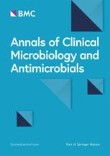
Abstract
Multi-Drug Resistant (MDR) Pseudomonas aeruginosa is one of the most important bacterial pathogens that causes infection with a high mortality rate due to resistance to different antibiotics. This bacterium prompts extensive tissue damage with varying factors of virulence, and its biofilm production causes chronic and antibiotic-resistant infections. Therefore, due to the non-applicability of antibiotics for the destruction of P. aeruginosa biofilm, alternative approaches have been considered by researchers, and phage therapy is one of these new therapeutic solutions. Bacteriophages can be used to eradicate P. aeruginosa biofilm by destroying the extracellular matrix, increasing the permeability of antibiotics into the inner layer of biofilm, and inhibiting its formation by stopping the quorum-sensing activity. Furthermore, the combined use of bacteriophages and other compounds with anti-biofilm properties such as nanoparticles, enzymes, and natural products can be of more interest because they invade the biofilm by various mechanisms and can be more effective than the one used alone. On the other hand, the use of bacteriophages for biofilm destruction has some limitations such as limited host range, high-density biofilm, sub-populate phage resistance in biofilm, and inhibition of phage infection via quorum sensing in biofilm. Therefore, in this review, we specifically discuss the use of phage therapy for inhibition of P. aeruginosa biofilm in clinical and in vitro studies to identify different aspects of this treatment for broader use.
Δεν υπάρχουν σχόλια:
Δημοσίευση σχολίου